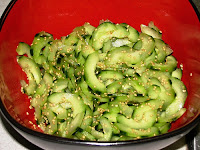Mmm, Chili. . . Who doesn't love chili? It's a seemingly simple dish with a complexity of flavors that can be molded to suit anyones craving. Best of all, it's good no matter what time of year it is. And everyone's got that Grandma, Grandpa, Aunty, Uncle, Mom or Dad that is known for making a killer bowl of chili. Some are known for making a ridiculously spicy chili, while others are known for making a mild but super savory chili. No matter what kind of chili it is, everyone loves it!
When I was young I would visit my grandparents every summer, and every summer I would learn a different recipe from my Gramma. Gramma was an awesome cook. She would make cooking, and cleaning, seem like a smallest of chores. The best part about her was that almost all of our vegetables came from her and Grandpa's garden. They were serious gardeners. She even taught me a system for cleaning dirty dishes as we made them, during the cooking process (best thing I ever learned in the kitchen).
Coming from Hawaii to San Jose, the weather was kind of a shocker for me. Super hot days with freezing cold nights. I was already familiar with the heat but with night temperatures below 60 degrees, I was always wrapped up in a blanket or jacket or towel or whatever I could get to keep warm. I loved the cold though, as long as I had something to keep warm when I needed it. It always felt refreshing and clean.
Well, one summer Gramma decided to teach me how to cook chili. What I loved about how she taught me things was that she would explain the whole process beforehand and while actually doing it she would go step by step on what we're doing and why we're doing it. I think the "why" was a key part in how I learned her recipes so easily. It's hard for me to do something without knowing the purpose or the outcome (applies to almost everything in life for me).
So for her chili, we had to buy the ground beef from the store, but everything else came straight from her garden. I helped her chop up all the vegetables while she carefully watched me, correcting when I need it too. She would tell me about how all the veggies need to be cut around the same size so that it cooks evenly together. Most of the men were tall, on my father side of the family. Since I was also very tall, I was tasked with grabbing the big heavy pots that Gramma was somehow able to store in the tallest part of her cabinets but never able to retrieve, at least while I was in town. She liked making chili in her heavy duty enameled cast iron french oven (not a cheap kitchen accessory). After everything was prepped and ready, we got started:
Gramma's Chili
Ingredients:
- 1 pound ground beef
- 1-2 onions, chopped
- 1 med. green bell pepper, seeded & diced
- 4 cloves garlic, chopped
- 2 cans stewed tomatoes
- 1 small can tomato paste
- 1 can kidney beans, drained & rinsed
- 1 can pinto beans, drained & rinsed
- 3 tbsp. chili powder
- 1 tbsp. garlic powder
- 1/2 tbsp. brown sugar
- 1/2 tbsp. cayenne pepper
- salt and pepper to taste
- water to cover
- flour & water for optional thickener
Preparation:
- In a large pot, combine ground beef, garlic, onions, bell peppers and sauté until meat is browned and veggies are tender.
- Drain excess fat and add stewed tomatoes, tomato paste, all dry seasonings and water (to cover).
- Bring to a boil then reduce heat and simmer for 45 minutes to an hour, stirring occasionally and adding water as needed, in 1/2 cup increments.
- Add kidney and pinto beans and simmer for additional 30 minutes.
- Salt to taste.
- Thicken with a mixture of flour and water, if needed.
If you make this recipe enough times, you'll learn how to thicken it up on it's own due to the tomato paste and pinto beans. But if you're on a budget and want to make little go a long way, you can thicken the chili with flour and water. Practice and patience is key.

After your chili is made, you can spruce it up with just about anything you want. Some like onions and cheese. Some like it in a bread bowl. In Hawaii we love it with rice. My personal favorite, however unhealthy it is, is with mayonnaise and on a heaping pile of rice. Yes, mayo! Just a spoonful is all it takes, but the chili becomes creamy and delicious!! There are numerous other things you can do with chili too, like throw it over homemade country fried potatoes and add some eggs (another personal favorite), or make an omelette, or just eat it straight up. Add some hotdogs or throw in on a hotdog. Options are endless.

Also in Hawaii is a local restaurant called Zippy's. It's a local favorite known for their fried chicken and chili, among other things. Actually, their whole damn menu is pretty amazing. The best part is that you can buy their chili by the bucket! And their chicken, and their mac salad, and their rice. It's fairly common for locals to buy each, by the bucket, and combine it all for one meal.
Who woulda thought that ginger and ajinomoto was in there!?!?!?! And did you notice the bacon? Wow! Try it out and tell me what you think!
Peace & Poi,
Dis Hungry Hawaiian





































